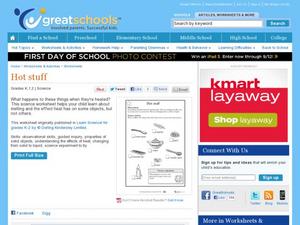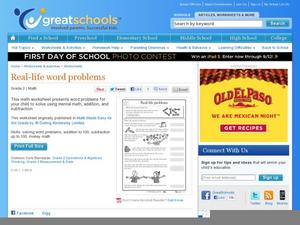Dorling Kindersley
Question Words
Teaching your primary learners how to ask questions? Then look no further. This worksheet introduces the six essential question words: who, what, where, when, why, and how. Children begin by practicing how to write these words, before...
Curated OER
Contractions
Shorten words with contractions. Second graders use apostrophes to shorten words, including harder ones like might not. Next, they write out the longer versions of various contractions. Have them write a story with these contractions for...
Curated OER
Question words, question marks
Practice the five W's and question marks with a fun grammar worksheet. After copying the words who, what, where, when, why, and how, kindergartners fill the words into various questions. For extra practice, have kids come up with their...
Curated OER
Hot Stuff
Very young scientists who are learning about solids, liquids, melting, and freezing will use this learning exercise to identify things that would melt if put in a warm place. There are eight objects altogether, and learners place a check...
Curated OER
Days of the Week
Cover both capitalization and the days of the week with a great kindergarten activity! Kids read each day of the week out loud, then write the name of the day on a line. They answer three questions about certain days of the week,...
Curated OER
Metals Can be Attractive!
After reading a short paragraph about metals and magnets, young scientists circle the things they think will be attracted by a magnet. There are six objects for them to consider. A nice worksheet to help get a discussion on magnets and...
Curated OER
Does It Move On It's Own?
Young scientists look at drawings of six animals, then match up a word that describes how they move. The words are: hop, crawl, swim, fly, run, and jump. They also answer two additional questions about the animals and how they move. A...
Curated OER
On the Right Circuit
After a discussion on how to make a light bulb light up in an electrical circuit, young scientists take a look at four circuits, and they choose the one they think will make the lightbulb light up. Use in conjunction with any initial...
Curated OER
Cool Stuff
Young scientists must place a check mark next to the answer they think is correct regarding things that are warm, cool, hard, and soft. This would be a good way to begin discussing how some things actually change states of matter...
Curated OER
Venn Diagrams
The Venn diagram is an important graphic organizer, and learners should be familiar with it. Here, pupils compare things that are made of plastic and metal, and they identify the things that have both substances in them. There are two...
Curated OER
Using Clocks: Analogue Clocks
What time is it? Have the class practice telling time to the half hour by reading and labeling each of eight clocks. On a second set of eight clocks, they use the time shown to draw in the missing clock hands. An answer sheet is included.
Curated OER
Being Alive
Young biologists use a activity to fill in the blanks of five sentences. Each one needs a word from a word band at the top of the resource. All of the sentences are about things that are alive, and how we know they are alive. The words...
Curated OER
Being Forceful
Young scientists consider the forces of push and pull, start and stop, and try to categorize each one correctly. There are five cartoon drawings of kids performing an activity. Learners must write push or pull, and start or stop in the...
Curated OER
For a Change
Here is a worksheet that has young scientists think about things that been changed as a result of heating and cooling, and if they can be returned to their original form. There are seven scenarios to consider, and they must choose,...
Curated OER
Simple Tally Charts and Bar Graphs
Introduce your first graders to the world of tally marks, bar graphs, and the organization of data. Pupils determine a favorite ice cream flavor based on tally marks, then use a bar graph to answer some questions about sports. There are...
Curated OER
Sorting Sets
Here is a simple sorting activity which is appropriate for pre-k and kindergarten learners. Pupils sort each of four items into the correct group, then count the totals and write the numbers in the boxes provided. Along with being a good...
Curated OER
Verb Tenses
Discover how to use proper verb tenses with context clues. Five sentences help first graders decide if they should use -ed or -ing to end simple verbs. Each sentence provides context clues to indicate the time. Use the resource in...
Curated OER
All About Me!
Reinforce punctuation skills as well as printing skills with a kindergarten autobiography worksheet. Youngsters write their information, including their name, address, and age, and draw a picture of themselves and the place where they...
Curated OER
Time - How Long Will it Take?
Youngsters think about the length of different periods of time. They label the seven most common units of time measurement, then answer eight questions that have to deal with those same units of time. A good worksheet!
DK Publishing
Sorting Fish By Pattern
Go fish! Preschoolers and kindergartners work on matching and patterns. This resource prompts little learners to match certain fish to the correct fisherman. They then count the types of fish and write the number in spaces provided....
DK Publishing
Spot the Doubles
Have fun with counting and ladybugs! Kindergartners count the number of spots on the first half of the bug's wings, then double the number to practice their addition skills. Have kids color the ladybugs when they're finished with the...
DK Publishing
Sneaky Snake: Numbers
Find the numbers that the sneaky snakes are hiding! Using a number table, primaries determine which numbers are covered up by snakes. They write in the numbers next to the matching snake below the table, which reinforces both counting...
DK Publishing
Learning Place Value
A great quiz for your place-value unit! Once your first graders have mastered the 1s, 10s, and 100s place values, assess their learning with these questions. Three sections prompt pupils to provide the number in certain places, and the...
DK Publishing
Real-Life Word Problems
Prepare your second graders for word problems with a straightforward review learning exercise. Use it after a unit on addition and subtraction up to 100, or after you have worked on money math. A sample word problem prompts young...

























